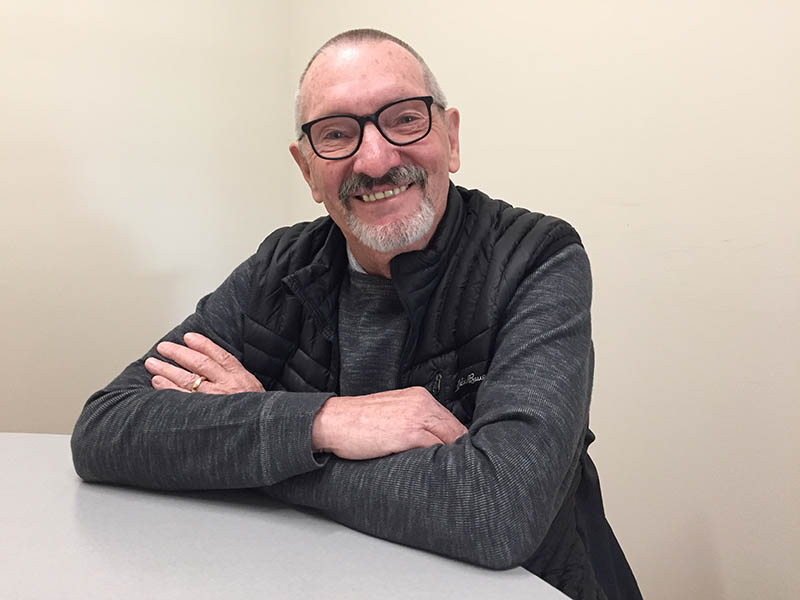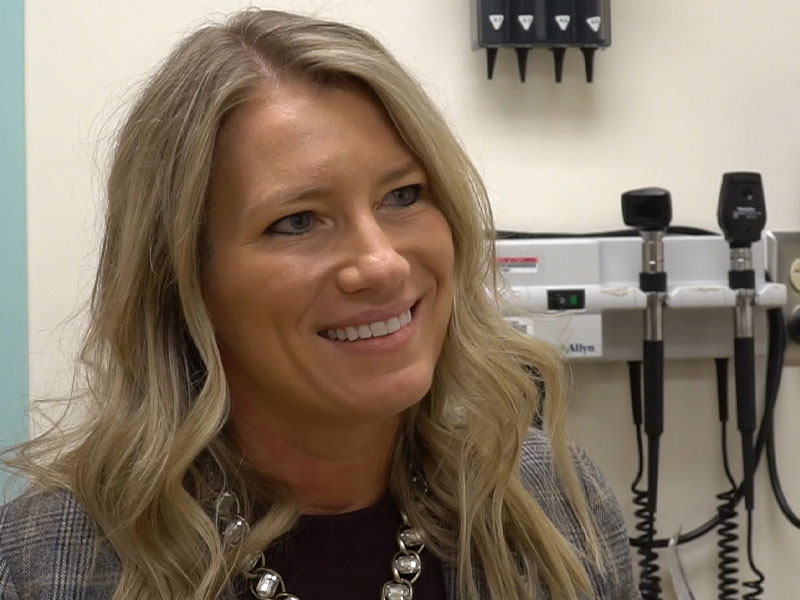Cystic fibrosis is a complex disease involving multiple systems of the body. Mucus fills not just the lung airways but also affects the digestive system.
A person born with the progressive inherited disease will spend their entire life cared for by a team of people. Appointments are frequent, with hospitalizations likely.
But a lot of advancements have happened in health care to raise the life expectancy of children born with cystic fibrosis (CF) from the teenage years a few decades ago to the 40s today. And now, a new medication could hold promise to lengthen further that life expectancy for the vast majority of patients.
Here’s a glance at how some of those improvements have played out, through the eyes of two people involved with the Cystic Fibrosis Care Center team at Sanford Health in Sioux Falls — the only center in the state of South Dakota.
Dr. Rod Parry, the first lung specialist in the eastern half of South Dakota, first oversaw the CF clinic. And Stacy Peters is the pharmacist who has worked with all of the CF patients at the clinic for the past 16 years.
‘We celebrated every life event’ with patients
Treatment — and with it, life expectancy — for cystic fibrosis has changed dramatically since Sanford Health began housing the cystic fibrosis center in the late 1970s.
At that time, the clinic focused on children and teenagers, since life expectancy then was about 14 years.
Starting out, a team of three gave CF care to patients about one afternoon a month: Dr. Parry, a social worker and a nurse.
“It was very important to us that the patients have local care,” Dr. Parry said. Otherwise, they would have had to travel to a larger city in another state.
Enlarge

Photo by Jane Thaden Lawson, Sanford Health
Early care consisted mainly of testing and identifying patients, setting up a program for them and ensuring that families had access to resources, said Dr. Parry, who’s now retired. Hours a day of in-home care for CF patients involved a lot of family support — “if the patient was lucky enough to have parents to do it” — in addition to the medical team’s guidance.
“We celebrated every life event we possibly could with them,” Dr. Parry said. “So when they graduated from high school, then that was reason for a celebration. And then a few started to get married — a reason for a celebration. Graduating from college, another celebration.”
But, he added, “at the same time, we had deaths. And at that time, the clinic was small enough that the three of us would always go to every funeral.”
Lengthening lives
Patients’ lives lengthened as newborn screening enabled earlier diagnosis and treatment. Also contributing were research discoveries, advancements in therapies and the team approach to care.
As more patients reached adulthood, the Sanford Health CF clinic separated into a pediatric team and an adult team. That was one of the first adult care teams for CF in the nation.
Dr. Parry started seeing patients become old enough to be parents. CF almost always causes infertility in males, but eventually, those patients had the option to try to have sperm collected surgically.
And he worked with female patients who wanted to get pregnant, to be sure they could handle the nutritional and lung function demands during pregnancy and delivery without deteriorating.
“That was an exciting time, but at the same time, it was a very worrisome time,” he said.
The Sanford Health CF clinic expanded to include respiratory therapists, dietitians, mental health providers and a pharmacist.
A unique pharmacist role
Peters has had a unique position as the Sanford Health pharmacist working with pediatric and adult cystic fibrosis patients, which she has been doing since 2004.
She doesn’t actually dispense medications to them. Rather, she meets with them regularly to go over their medications and spot potential side effects, providing education and watching for what might be optimized, such as dosage or a new medication.
Some patients Peters might see only once a year, but others can be much more frequently. Those might include patients fighting an infection with a complex regimen of antibiotics, or patients on medications with long lists of drug interactions. She often talks daily with patients finishing up an IV round of antibiotics from home, who require close monitoring for harmful side effects.
“Sometimes we talk way more than they would like to talk to me,” Peters said. But, she added, “I do get to know my patients very well, which is very enjoyable.”
Peters spends half of her time working as a professor of pharmacy practice at South Dakota State University. Currently in the CF clinic, she sees about 100 pediatric patients and 50 to 60 adults, a number that has grown since she began.
She has seen some patients that entire time as they progressed from childhood to adulthood.
Like Dr. Parry, Peters has watched sadly as cystic fibrosis defeated some patients, including some her age. “I think of myself as somebody who’s healthy and young, and to see these patients die at such a young age when … you’re finally almost getting your footing in life, that’s been very hard.”
But she, too, has enjoyed seeing many other patients live to hit milestones like graduations, weddings, babies and the pursuit of their life dreams.
New medications ‘earth-shattering’
When Peters started working with patients in the CF clinic, the main medications available to help them were pancreatic enzymes for digestion; vitamins; medication to help open lungs and thin the secretions; and, during exacerbations or illnesses, oral or IV antibiotics.
Until less than a decade ago, medications, along with vest treatments to vibrate the chest wall and loosen mucus, were “all treating the aftermath” of cystic fibrosis, Peters said.
Then along came the first medication that could “fix” the erroneous protein made by the cystic fibrosis transmembrane conductance regulator (CFTR) gene.
“That was earth-shattering, because what they were doing is they were actually fixing the underlying defect that causes CF,” Peters said.
However, that first CFTR modulator, which improved lung function and quality of life, could help only 5% of people with CF, who had a certain uncommon set of mutations. So Peters could give it to just a few of her patients. “But the results we were seeing – just insane,” she said.
After that, two more CFTR modulators came along that worked “modestly well” in 50% of CF patients. The results weren’t as dramatic as with the first. Peters said they resulted in small improvements in lung function, and they seemed to keep people from getting sick as often.
Then last October, results from clinical trials convinced the Food and Drug Administration to approve a new drug months earlier than it was set to. Trikafta showed effectiveness in improving lung function and reducing exacerbations and, consequently, antibiotic use for gene mutations that affect 90% of CF patients.
Seeing improvements
Sanford Health had participated in clinical trials leading to the development of Trikafta, which combines three medications, Peters said. So she had some early insight. And after Trikafta’s approval, she, and the CF clinic, suddenly became very busy. Patients had to get lab work done before getting their prescription for the pills.
“Within a few weeks, we are getting phone calls, maybe some text messages, telling us about what’s happening when they take Trikafta,” Peters said.
Some described coughing up cups of sputum from their lungs. But that’s a good thing. “All of a sudden, they’re getting rid of all this old stuff that was in there,” she said. “We saw people have 20% improvements in their lung function, which is unheard of in CF.”
The degree of improvement seems to correlate with how severely a person’s lungs have been damaged, Peters said. But even if lung function improves only modestly, people have seen changes. They can tolerate exercise better, they’re less fatigued and breathing is easier. And one side effect is helpful for this particular group of patients: weight gain.
Dr. Parry recalls the excitement in 1989 when the gene for CF was first discovered — a significant development in understanding the disease.
“We were so naïve,” he said. “Little did we know that it was going to be much more complicated than one single gene abnormality.”
More than 1,700 mutations on that gene are now known to cause CF, according to the Cystic Fibrosis Foundation.
Identifying patients’ specific mutation or mutations helps determine whether one of the CFTR modulators may work for them.
Dr. Parry hopes Trikafta can result in a more normal life. But he points out 10% of patients have no CFTR modulator. And he worries interest may wane in pursuing further medications or treatments if people mistakenly consider Trikafta a cure.
“We don’t have a cure,” he emphasized. “We just simply have a control — something to control the disease.”
More stories
- Woman fights against cystic fibrosis with voice, passion
- Raising a child who has cystic fibrosis
- Carrier test shows what genetics parents may pass to kids
…
Posted In Children's, Pulmonology, Sioux Falls, Symptom Management
